Why should one bother with building a complicated network with tons of signals and stuff? This question is asked by most newcomers to the game. The answer is rather simple: You will run out of space for building a dedicated track for each train. And with a simple double tracked line it is easily possible to have more than a dozen trains running on it. When having to change a connection or add access to the next factory, this becomes much easier compared to building a whole new connection. In the long run, you save lots of money that can be invested in vehicles (aka moneymakers).
There is one disadvantage, though. Trains in badly designed networks might get lost or block each other. But these problems can easily be circumvented when keeping some simple basics in mind when building the network. And that is what this page is about.
Single line
Single line setups are the cheapest way to connect two stations. As the name suggests, there is only one track which is used in both directions. On such a line exactly one train can travel, for more trains you need - surprise, surprise - switches and signals.
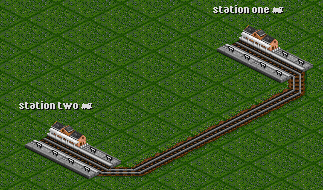
This most simplistic form can only handle one train that travels between both stations. Between both ends of the line additional stations can be built, but as long as they do not have more than a single platform and appropriate signalling, the capacity of the line is still limited to a single train.
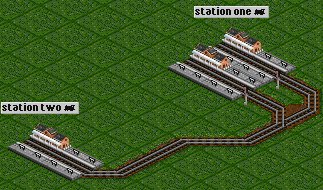
Using path signals in this way enables trains to reserve their path from the left station up into the right one (standard path signals are ignored when crossing from the back side), while trains going left have to wait at the signal until the track becomes available. That allows running two trains on this setup, one waits in the station to the right while the other one is on its way between the stations.
Theoretically one could replace the path signals by two-way block signals. It would not change the fact that only two trains can use these rails, and when later on extending the line one would most likely have to switch to path signals anyway, so it is just easier to use path signals right away.
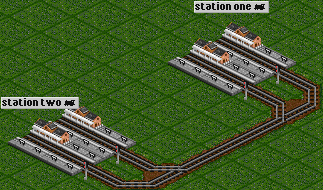
By extending the station to the left, now up to three trains can run here without blocking each other. One train has reserved the path between the station into the current destination station, the other trains have to wait.
By reserving the paths it will also (at least for three trains) alternate between trains going back and forth: Assume that there are two trains in the station on the left, the third one in the station on the right. That means one of the two trains from the left has to go the right, as there simply is no other possible way. Afterwards, a train from the right hand side has to go to the left, as again only that station has a free track to go to. The tree trains therefore always switch back and forth.
This setup can be expanded, with each new platform allowing one more train. However, as the connection between the stations remains a single line, this is not very useful as trains would wait for a green signal most of the time. It is much more useful to add passing places.
Shared tracks
Usually, lines will meet at stations, or there are parts which will be used by several trains together. It is necessary to place the signals correctly for this to work, as shown in the next images.
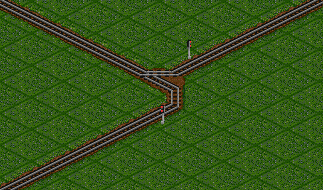
Both single track lines to the left and right share the central track. Before being able to use the central track the trains have to reserve a path. When going in the other direction (from the central track to the left or right) no train can block - only one train per line is possible with this setup.
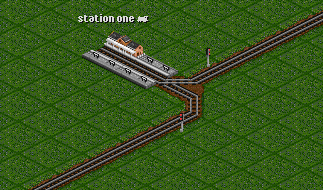
Instead of sharing pieces of track, trains can share a station just as well. Signalling works in the same way. Of course, there is still the limit of only having one train per line, so two trains in total.
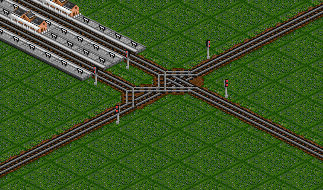
Sharing larger stations can be realized in the same way: You just have to take care that trains entering the shared parts (the junction before the station and the station itself) have reserved a path through said area. That is why the signals are all facing the junction area. As long as there is only one train per line, no blockage can happen.
The layout of multiple one-track lines sharing a station can be extended easily, either by adding further one-tracked lines, by adding tracks to a line, or by enlarging the station.
Passing places
Bigger stations at the end of the line do not help much to raise the capacity of the line, as long as trains cannot pass each other outside the station. To make this possible, passing places (sidings) have to be built.
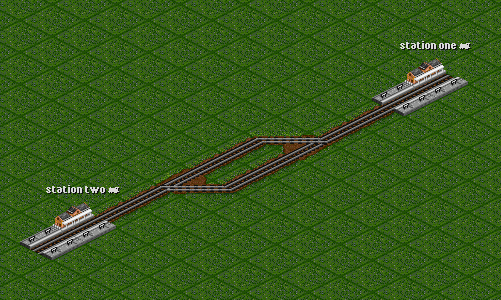
This is how a track with a passing place looks in principle: a one-track line connects the two stations, in the middle there is a double-tracked section (the signals have been left out here on purpose, this will be discussed in the next sections). To make the passing place work, the tracks there have to be long enough to fully accommodate any train traveling on the line, so that they do not block any switch tile when waiting. With such a passing place on the line, two trains can use the line, one on the single-track section to the left, the other one on the right.
You also have to be very careful about signalling here: If trains can block each other at a passing place, they eventually will do just that, forcing the player to manually solve the problem. Still, this can be prevented by adhering to a simple rule:
So how can the rule stated above be fulfilled? There are different options with different signal types, but the only solution that is guaranteed to work is the usage of path signals.
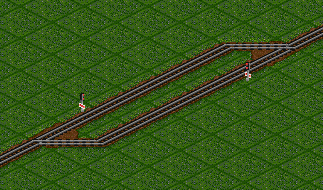
This is one of the places where one-way path signals are necessary. They prevent trains from going through the passing place on the wrong track. This could happen when using the standard path signals, since they can be passed from the wrong side. Using one-way signals forces trains to reserve the correct path into the passing place. Trains going the other direction have to wait until the track becomes available. When there already is a train waiting in the passing place, no other train can follow it because no path can be reserved. This ensures that trains cannot block each other.
For longer single-tracked lines one can build multiple passing places. Each of them needs to be built in the same way and with the same signal layout. The maximum capacity of the line is then equal to the sum of single-track sections between the passing places: In each such section exactly one train can travel.
Instead of having tracks in a passing place, one could also build a station there. One can also increase the size of the passing place / station by adding further tracks to the left and right and placing the signals in the same way for the corresponding driving direction. However, increasing the size is not that useful, one should rather add a second track to the line.
Shared tracks revisited
As already briefly discussed in the part about one-tracked lines, adding passing places into the setups might require some changes to signal placing. The examples from above are repeated here with explanations what has to be changed.
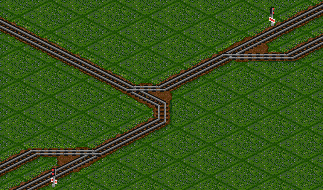
When sharing one-tracked lines or stations the two-way signals which separated the different lines have to be removed. Their task is taken over by the signals in the passing places. Trains now always reserve the whole track, including the parts that are shared with the other line.
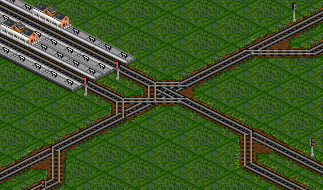
Sharing larger stations in combination with passing places is easily possible. Just remove the signals at the entry to the junction in front of the station, since their task is taken over by the signals at the passing places. Trains now reserve the whole path from the passing place right into the station.
A possible problem with this setup will be that the trains will reserve the whole track from the passing place, across the junction area in front of the station and into the station itself. That will block the junction section at the station for longer periods and may block other trains for unnecessary long times. One could be tempted to add additional path signals at the station (as in the original layout without passing places): This will fail, as a train may end up waiting in front of a full station, preventing trains from leaving, thus creating a total blockage. Such a setup would violate the base principle for passing places: A train may only leave a passing place and go into a single-track section when it has reserved a way out of that single-track section.
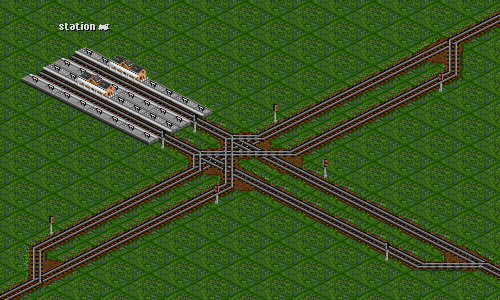
This layout uses passing places directly next to the station to avoid long time blocks of the junction area in front of the station. A train can always leave the station, in the worst case it has to wait at the passing place in front of the single-track section. Still, other trains could then already use the station. The passing place is long enough to allow a train to wait without blocking the junction before the station.
Shared tracks revisited
For large-scale tasks (meaning many trains), single tracks are not enough, because of the increased interference of trains with each other. The capacity of a track that is used in both directions is just too small. The solution is simple: One dedicated track per direction. This will result in two tracks and huge capacities or just about any task. Most railway lines in the real world are built in that way as well.
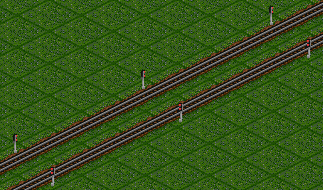
This is the standard double-tracked line. Noteworthy are the path signals placed in regular distance (one can also use block signals instead, it would not change anything about how the line works, but just placing path signals everywhere on the network makes things much simpler). These signals act as automatic signal block (that's the term in the real railways) and increase the line capacity. The closer these signals are placed, the sooner a train can follow, and the more trains can run on the line in the same time. In reality, signals are placed several kilometers apart, in the game a distance of about three tiles is usable very well.
Double-tracked lines have enough capacity for most tasks, even with many trains running on them. In order to create a well-working network, well-working junctions will have to be used. This topic is rather complex, therefore it is discussed on an extra page about junctions and crossings.
In real networks, trains can often switch onto the "wrong" lane (the one for the opposite direction) in order to overtake slower trains. This can also be done in the game, although one should only try it on lines with not too much traffic, because that would only lead to train blockages. This system is especially useful if the trains have a huge difference in speed, i.e. for express trains overtaking slow freight trains.
When building switches for the trains to switch tracks one should take care that trains cannot change their direction by doing a 180 degree turnaround - that is unrealistic and can wreak havoc with the traffic on the line. Usually it is a good idea to turn of the feature that trains can run across 90-degree corners anyway.
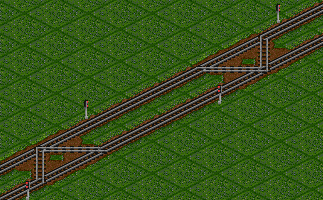
A double-tracked line with path signals can easily be enhanced to allow switching tracks. One just has to add the track connections, and that's it. Trains now reserve their way using both tracks as possible and return to the correct track after overtaking.
This switching of tracks does not work well on busy lines, as oncoming trains will prevent trains from "overtaking" - same as on a busy road where it becomes almost impossible to overtake as there are always oncoming cars. A solution for such busy lines are dedicated overtaking sections with additional tracks. Their setup and how to do the signalling for it is described in overtaking sections.
